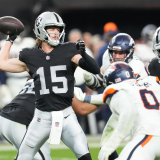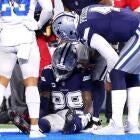
How Bills' Dalton Kincaid will make Josh Allen's life easier, creating similar setup to Cam Newton in Carolina
Buffalo trading up for tight end Dalton Kincaid in the 2023 NFL Draft could re-shape its offense

The Buffalo Bills have been one of the NFL's most dominant teams across the last three regular seasons, leading the league in points per game (29.4) and points allowed per game (19.4) in that span. However, they have also continually bumped their head on a golden ceiling in the postseason, losing to the two teams to represent the AFC in the Super Bowl across the last three years in the Kansas City Chiefs and the Cincinnati Bengals.
Quarterback Josh Allen once again provided Buffalo with gigantic production in 2022, ranking second in the entire NFL to only MVP Patrick Mahomes in total yards (5,045) and total touchdowns (42). The issue was he also led the league in turnovers with 19 -- 14 interceptions (tied for the third-most in the NFL) and five fumbles lost (tied for the second-most in the NFL). Allen became erratic as Buffalo asked him to be its No. 2 running back -- his 124 carries and 762 rushing yards were the second-most on the team while his seven rushing scores led the Bills -- behind James Cook.
"I know this sounds crazy, but I'm getting older," Allen said April 19, via the Bills' team website. "It's like I can't continue to do this. I know when I'm using my youth I feel like I can, but over the course of my career, I'm going to have to learn to adapt and change. And I've always had the mindset of I've been a football player first and a quarterback second, and at some point that's going to have to switch. When that point is I don't know; I guess I'll let my body tell me."
Naturally, general manager Brandon Beane heard the face of his franchise's message loud and clear, so he prioritized making Allen's life easier in the 2023 NFL Draft. Then, perhaps Allen won't feel the need to be Superman and act as another rusher on top of being the team's passing game conductor. Buffalo selected the draft's top pass-catching tight end, Utah's Dalton Kincaid, 25th overall, and one of the draft's top offensive guards, Florida's O'Cyrus Torrence, 59th overall (Round 2), with its first two picks. Beane even parted with a fourth-round pick to move up two spots (from 27 to 25) in order to select the first tight end in the draft.
The vision: providing the football equivalent of bumpers at a bowling alley over the middle of the field to limit Allen's gutter balls (giveaways) thanks to having two capable pass-catching tight ends who are both at least 6-foot-4 while weighing at least 240 pounds in Kincaid and Dawson Knox. It's the same strategy Beane utilized as a member of the Carolina Panthers front office in the early 2010s when building around another dual-threat dynamo and eventually 2015 NFL MVP Cam Newton. Current Bills head coach Sean McDermott also observed Newton's development with a similar roster construction in Carolina, as he was the Panthers defensive coordinator from Newton's rookie year in 2011 through the 2016 season.
"We've been looking for another tight end," Beane said April 27 after Round 1 of the 2023 NFL Draft. "When we just drafted Cam Newton in Carolina, the first year we had Jeremy Shockey and then we traded for Greg Olsen in [training] camp, just two guys to work the middle of the field. Twelve personnel [one running back, two tight ends, and two wide receivers] was one of our stronger personnels.
"We're more of an 11 [one running back, one tight end, and three wide receivers] team, but again. with [Kincaid], we're kind of an 11.5 when he's in the game. It's not two true Y's [tight ends who exclusively line up on the end of scrimmage next to the offensive line]. [Kincaid is] a piece that can work the the inside of the field for us, and we're excited to get him here. Really good hands."
Newton's first year with the two tight end setup ended up being his most prolific in terms of passing yards (4,051), as he became the first rookie in NFL history to throw for more than 4,000 yards. Only three others have done so since: Andrew Luck (2012), Jameis Winston (2015) and Justin Herbert (2020). Beane made it crystal clear that Kincaid was the Bills' only option in Round 1 and that his role with the team is as the "F tight end" or the third receiver in 11-personnel formations. While the team signed Knox to a four-year, $52 million extension a year ago, Kincaid will not be playing Knox's role. Knox serves as the "Y tight end," a player who regularly lines up on the line of scrimmage next to offensive linemen and carries regular blocking responsibilities in addition to a route-running role.
"If Dalton was not there, we would've traded back," Beane said. "We just really liked him and just felt he would be a great fit in our offense. He is a tight end but he is a receiving tight end. We think he'll pair well with Dawson and give us another target in the middle of the field. So yeah, when [he] and Dawson are in the game you're in '12' but it's quasi-like '11' anyway. ... He's not your standard Y tight end. He's going to be flexed out a lot more than necessarily you would do with Dawson.
"I think that [Kincaid is] just another weapon for [offensive coordinator Ken] Dorsey," Beane continued. "Dawson's still gonna be very involved. Like I said, Dawson will play more of that traditional 'Y.' [Kincaid will] play more of the 'F' for us, so like I said -- it'll just be a different package. But Dawson is a clearly better in-line blocker, still a receiving threat, so I don't think Dawson's gonna be goin' anywhere."
The reason Beane is categorizing Kincaid as essentially an additional receiver is because Allen performed significantly better in 11 personnel than he did in 12 personnel in 2022 when facing defensive sub-packages instead of his opponents' base defenses. The Bills, as a result, lined up in 11 personnel 68.4% of the time last season, the ninth-highest rate in the NFL. On the flip side, they avoided the two tight end look like the plague a year ago, lining up in 12 personnel a league-low 3.7% of the time. However, the Bills didn't have a jumbo-sized receiver with Kincaid's route-running fluidity last year, either.
Josh Allen passing in 11 personnel vs. 12 personnel in 2022 (NFL ranks)
| 11 Personnel | 12 Personnel | |
|---|---|---|
Comp Pct | 64% (22nd) | 66.7% (T-14th) |
Pass YPG | 206.4 (5th) | 8.5 (22nd) |
Pass Yards/Att | 7.5 (7th) | 6.0 (29th) |
TD-INT | 30-12 (11th) | 0-0 (No rank) |
| Passer Rating | 98.2 (6th) | 82.8 (25th) |
The long-term game plan is clearly to have Kincaid as the team's new slot wide receiver over the middle with Stefon Diggs and Gabe Davis on the outside since Beane likened Kincaid to their former third option over the middle, Cole Beasley. But the difference between Kincaid (6-foot-4, 240 pounds) and Beasley (5-foot-8, 174 pounds) is stark. With Kincaid's additional catch radius, the Bills believe there's another, more efficient Allen that can be unlocked while playing football on rookie mode instead of "All-Madden," the hardest level in the league's video game series.
"Elite hands, really good route-runner, good feel setting up guys inside," Beane said of Kincaid. "There's always the card as a player telling you what to do eight yards here or there, but sometimes the defense changes, and this guy's got great feel, great instinct. You guys saw from a different position, Cole Beasley, great feel. This guy, in a different body type, does that."
Buffalo doggedly pursued ways to upgrade its offensive line and Allen's arsenal of playmakers in 2023, all in an effort to answer the question of "when will the Bills break through the crowded AFC and reach the Super Bowl?" They hope Kincaid's ability to separate provides the final piece of the puzzle that is appearing in the Super Bowl for the first time in three decades and hoisting the Lombardi Trophy for the first time in franchise history.




















